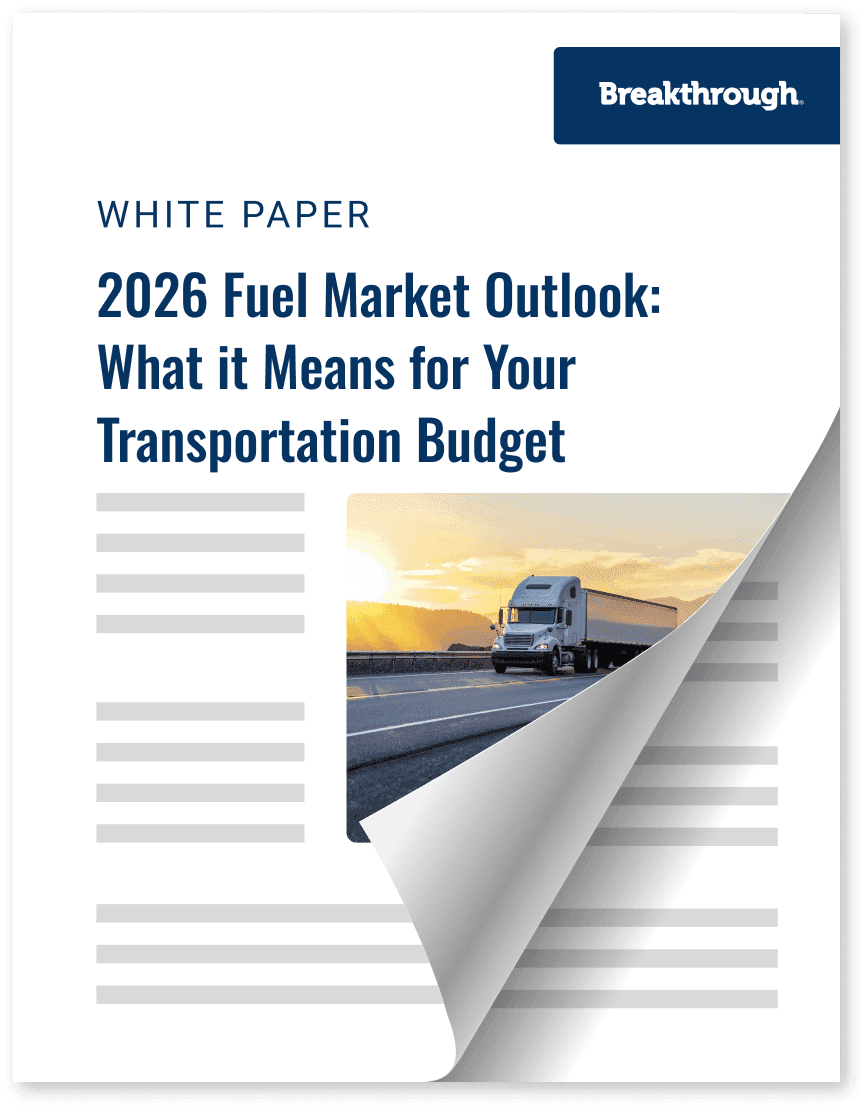2026 Fuel Market Outlook: What it Means for Your Transportation Budget

Trending
Top Posts
8 min read
September 14, 2020

Share:
Table of contents
Browse the table of contents to jump straight to the part you’re looking for
Crude oil is often a central tenet of headlines and boardroom discussions because its demand is widespread and its price is volatile. Crude oil is almost always a basic supply and demand equation: how much oil does the marketplace need, and how much is available? This balance determines prices which, in turn, influence trade dynamics, policy decisions, environmental effects, and the bottom line for manufacturers, retailers, and shippers who are key consumers of crude oil products.
In terms of supply, a few large players have historically had a majority of the influence, most notably, a cohort of oil-exporting countries called the Organization of Petroleum Exporting Countries. This group is commonly known as OPEC.
OPEC is a cartel of oil-producing countries that unites under one common goal: to maintain and stabilize international crude oil prices.
OPEC has the capacity to produce just over one-third of the world’s oil, which makes even slight changes to their collective output more notable than most other exporters.
Since their inaugural meeting in Baghdad in September of 1960, OPEC maintains its mission to “coordinate and unify the petroleum policies of its Member Countries and ensure the stabilization of oil markets in order to secure an efficient, economic and regular supply of petroleum to consumers, a steady income to producers and a fair return on capital for those investing in the petroleum industry.”
Balance is key, and maintaining a profitable price point without over-restricting the marketplace remains the organization’s main goal.
Founding members Iraq, Kuwait, Iran, Saudi Arabia, and Venezuela created OPEC to monitor the crude oil prices and make collective decisions about how much they need to produce to remain profitable. If prices are high, the cartel has room to produce more. When prices sink lower and demand disappears, the group will limit their output until supply and demand are more balanced.
Conversely, in a tighter oil market where supply and demand are closer to equilibrium, their satisfaction with prices makes intervention less likely.
Prior to OPEC’s formation, price dynamics were often determined by a series of U.S.-dominated multinational oil companies. As OPEC has grown to include a contingent of allies, like Russia, OPEC(+), or the Vienna Alliance, now includes over 18 countries, supplying over one-third of the world’s crude oil production and controlling more than 80 percent of the world’s proven crude oil reserves.
Today, these representatives meet twice a year in Vienna, Austria, where they collectively decide whether to raise or lower oil output to maintain a stable market. Such manipulation of supply has historically been an effective means of oil price control for the cartel. But this is changing in today’s U.S.-centric oil market and amid crude oil price disruptions caused by the pandemic.
OPEC’s supply decisions could be viewed as either a mechanism to secure consistent oil supply or as a method to maintain prices at a profitable level for their organization. Regardless, it’s also important to view the larger story of production and consumption worldwide when evaluating the organization’s historical impact.
With more than three-quarters of the world’s proven oil reserves controlled by member nations, OPEC has historically modulated prices with the knowledge that most countries could neither compete with its abundant oil reserves nor create a competitively viable energy alternative. Because of this, a cyclical market dynamic naturally develops.
In the years of economic expansion that characterized the early 2000’s, OPEC’s stabilization efforts were effective. Large global economies like the U.S. and China expanded and increased demand sending oil prices toward highs near USD $140.00 per barrel.
A side effect of these high prices, however, was that it also made it profitable for non-OPEC countries to develop and test new ways of exploring and extracting oil at home. This prompted the U.S. to develop new shale oil extraction techniques to become profitable producers in this high-price environment.
Although the 2008 recession temporarily halted the development of shale hydraulic fracturing technology in the U.S., the following years saw a dramatic increase in fracking for crude oil extraction. Because the U.S. is not an OPEC member and does not have to abide by its decisions, the country grew its domestic supply levels, which eventually culminated in the crash of global oil prices at the end of 2014.
OPEC production figures post-2014 moved opposite to WTI price for a period of two years, attributed to the organization’s decision not to cut crude oil output. At the end of 2016, however, following the decision to cut production for the first time since 2008, output decreased and has continued that downward trajectory as cuts have been extended to the end of 2019.
Despite this glut of oil on the market as 2014 ended, OPEC did not choose to cut production levels. They chose, instead, to prioritize the preservation of its market share and continue producing at a rate near 30 million barrels per day (mmbd).
Following this decision, West Texas Intermediate (WTI) crude oil and wholesale diesel prices fell close to 10 percent and continued that downward trajectory before reaching multi-year lows in 2016. The chart above shows the relationship between the oil and diesel market, highlighting OPEC’s influence on energy prices and the international supply picture, in total.
With the oil market becoming increasingly less profitable for the cartel and other non-U.S. producers, OPEC and newly invested parties like Russia soon began discussions to freeze and even cut, production levels to add greater stability to oil prices.
While the group initially had trouble arriving at an accepted metric for these cuts, at the end of 2016 the group reached a consensus. The outcome of this decision was the first production cut OPEC had made since 2008 and has since resulted in a period of prolonged cuts by the organization.
These cuts remained influential price drivers but have varied in the magnitude of their impact. In June 2017, less than a year after OPEC’s production decision, cuts were extended, resulting in an increase of almost 40 percent by the group’s meeting the following year.
With this upward-trending market in mind, OPEC endorsed a production increase to stabilize prices during their semi-annual meeting in June of 2018. This was later rescinded as the bear market of late 2018 materialized in response to concerns of an oversupplied oil market, sending oil and diesel prices into a downward spiral to close the year.
While all of these factors initiated the transition, the emergence of “the big three” crude oil producers expedited OPEC’s more reactive role in the marketplace.
Take a deep dive into this evolution here.
In July 2019, OPEC again decided to maintain production cuts. The market’s slower economic growth and its impact on global demand for crude oil and transportation fuels greatly reduced OPEC’s potential to push prices upward by restraining oil supply.
Since their decision to implement supply cuts of over 3.0 million barrels of crude per day from October 2018 levels, OPEC’s removal only modestly increased prices during their most recent round of cuts. This is due in large part to US oil production growth counterbalancing OPEC’s efforts to remove supply from the market.
With this in mind, OPEC has recently transitioned to become OPEC+. The addition of the “+” contingent of non-members indicate countries who agree to team up on organizational decisions but are not bound by true membership. The alliance now includes Kazakhstan, Mexico, and perhaps most importantly, Russia – among others.
Historically, OPEC nations and Russia viewed each other as rivals instead of allies, with the latter as the world’s third-largest oil producer behind the US and Saudi Arabia. Since December of 2018, OPEC+ members once again control most of the world’s crude oil supply, combining their respective influences on the global market to influence prices.
While this new partnership may offer additional leverage to OPEC+, fears of global economic slowdown amidst the US-China trade war may continue to overshadow the upward momentum of supply cuts.
With all of these developments in the rearview, 2020 has presented completely novel crude oil environments that involve OPEC, its allies, and the greater economic landscape which culminated in crude oil prices sinking well below zero for the first time in history.
In a series of unprecedented global events, the supply and demand balance swung swiftly toward surplus. Saudi Arabia and Russia entered into a price war that resulted in a produce-at-will mentality that sent production to historic highs. At the same time, demand for crude oil products, notably gasoline and diesel, disappeared in a matter of days and weeks as COVID-19 shuttered businesses and kept consumers at home.
You can read a full analysis of how, and why, crude oil prices crashed on our blog.
Despite OPEC’s influential history of price control, new dynamics in the global economy, and continued growth from the U.S. and other oil producers may continue to reduce OPEC’s ability to manipulate prices. Regardless of how these dynamics change, understanding who OPEC is, what its role in the market intends to be, and how they make their decisions will remain important for organizations whose budgets depend on its refined products and prices.
Interested in reading more OPEC-related topics? Learn more

6 min read
November 20, 2025
Understand the impact of Ukrainian drone strikes on Russian refineries. Learn why diesel prices are volatile and how to protect your budget from market shocks.
Read more
7 min read
November 11, 2025
Discover how fuel management systems cut costs, track emissions, and improve reimbursement accuracy for modern freight operations.
Read more
6 min read
November 10, 2025
Explore how the proposed Union Pacific–Norfolk Southern merger could reshape rail in the U.S. Learn impacts on competition, pricing, and service.
Read more